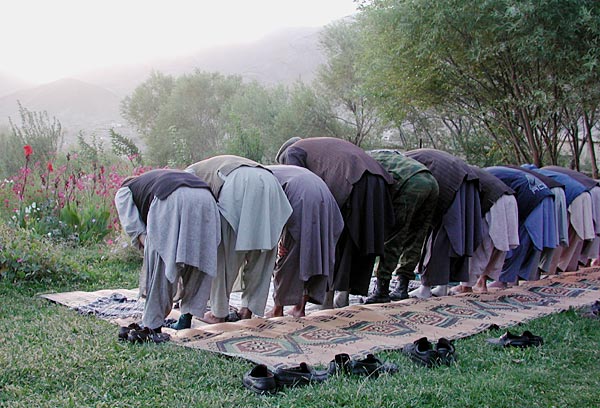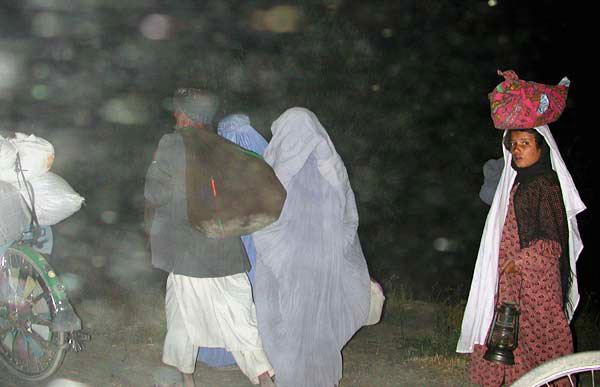Islam is the prevailing religion in Afghanistan. The majority of Muslims adhere to the Sunni school, while Shi’ites are in the minority. There are also some Christians, Bahais, and Hindus; in Kabul, there are two Jews (as of this writing in 2002).
Most Afghans are devout Muslims. Out of fear of Allah or public opinion, or due to the sheer depth of their faith, they normally obey the main tenets of Islam in their day-to-day life. This means praying several times a day, observing ruza, or daytime fasting, during the holy month of Ramadan, and keeping other traditional rites and customs.
One of such customs is to fiddle around with rosary beads, or tasbih, which, apart from being an element of religious exercise, is said to relieve stress. Rosaries come in various types: plastic beads, gemstones, wood, and any other material imaginable, which determines their value, from a few afghanis to a few hundred dollars. They say in Afghanistan that a rosary has no master, or owner, so if you get hold of someone’s attractive and, hopefully, expensive tasbih, keep it. But I wouldn’t advise playing this trick on the man in the photo to the left.
Speaking of interesting customs, it is worth mentioning the Afghans’ superstition or, as the case might be, religious rule, to enter a house with the right foot first, as opposed to the left foot, which should be the first to step into a toilet. Even doors to these premises are designed in different ways so that they open according to these unwritten regulations. Besides, when an Afghan puts on his or her shoes, he or she is likely to start with the right foot.
Some Afghans, especially those who studied in the former Soviet Union or lived in the West, do not usually object to sharing a bottle of vodka or whiskey with their drinking foreign friends. For the majority of other citizens, alcohol is taboo. Engineer Imran told me the most important thing for a drunk person was not to be caught by police who might mete out sever punishment. Wives, unacquainted even with the smell of alcohol, do not present any problems. “If she asks me about the smell, I’ll tell her I drank Coca-Cola,” Imran told me one evening during a hearty meal of kebab and pilau with Russian beer, smuggled from across the Uzbek border, which we bought for four dollars a can under the counter in one of the food stores in Mazar-e-Sharif. A bottle of vodka cost about forty dollars those days.
As a matter of fact, when Prince Vladimir I of ancient Rus was looking for a proper religion for his country, he rejected Islam, because it forbade alcohol consumption, and embraced in 988-989 AD Christianity thanks to its more liberal attitude to drinking. No wonder Vladimir is one of the most popular given names in Russia even today.
Afghanistan always lived by its own solar calendar, which counts years since the Hijrah, which is when the Prophet Mohammed migrated from Mecca to Medina (approximately July 622 AD). Saudi Arabia and some other Islamic countries stick to their own version of the Hijrah calendar based on twelve lunar months, the beginnings and endings of which are determined by the sighting of the crescent moon. In 1999 AD, the Taliban authorities adopted the lunar calendar, but in February 2002 AD, the new Afghan government reintroduced the traditional solar calendar, which switched the year from 1423 to 1381 of the Hijrah era. This said, one is not going to be surprised any more by the fact Afghans don’t know their exact age and don’t celebrate birthdays. Would you?
Religion’s grip on the life of Afghan society somewhat softened with the collapse of the Taliban, or Knowledge Seekers, who purportedly represented the strictest version of Islam. In fact, many Islamic scholars in Afghanistan and other countries say the Taliban were not true Muslims and were themselves responsible for violating Islamic law, or Sharia. Anyway, with the departure of Taliban religious police from the streets, palmists were seen reading the palms of citizens keen on learning their future, movie theaters reopened to show Indian love stories, and even pop music, domestic and foreign, was heard from inside music stores, which also sold – clandestinely and only to trusted customers – pornographic videos. Most women, however, still kept their burqas.
Muslims pray everywhere. In 2001, in the Do-Ab camp for Taliban prisoners of war, inmates were allowed to leave their cells several times a day for prayers on the stony beach.
Their arch-enemies from the Northern Alliance army performed their religious rites several hundred meters away from the front line.
The majestic Rauze Sharif Mosque in Mazar-e-Sharif, the capital of Balkh Province, attracted thousands of believers for a major service every Friday. All men, with the exception of soldiers, were obliged to remove shoes before entering the mosque.
Women were not allowed into the mosque, so they congregated outside. Those were mainly poor ladies who waited for alms handed out by men after the service. Very often, a crowd of believers was too large for the mosque, so men placed their mats on the tiled square and prayed outside.
During sermons that preceded prayers the mullah and other spiritual leaders usually spoke about daily problems as well as international politics. For ten dollars, mosque officials allowed journalists to film inside the “Blue Mosque.” Mohammad Qasim, the chief mullah, is a very articulate man who was happy to talk to reporters about current topics. But he was very careful in his comments about al-Qaida and Osama ben Laden. He said the Afghan people were against terrorism, but they didn’t know anything about Osama because they had only seen him on television but never met in person. Yes, there was television in Mazar-e-Sharif, and people eagerly watched news bulletins and Indian movies on television in stores and street cafes. Very few people owned television sets because the Taliban, which did not approve of television, had confiscated and destroyed television sets in private possession when they seized power in the city.
The Muslim faithful are expected to wash certain parts of their bodies before prayers. In the city of Taloqan, Takhar Province, children took advantage of the situation by renting out ablution jugs, and their business was flourishing.
In Afghanistan, religion has always been both the cementing force that helped keep all the numerous ethnic groups together and the main cause of conflict. The Shi’ite Hazara people, as opposed to the majority Sunnis, were not even considered Muslim by the Taliban, which eventually led to mass executions.
In Mazar-e-Sharif, during their four-year-long rule, the Taliban killed about 15,000 local Hazari and destroyed their houses for the only reason they belonged to a wrong branch of Islam and a wrong ethnic group.
Taliban soldiers forced their victims to march in groups, from fifty to fourteen hundred, to the outskirts of the city, tied their hands with rope or electric cord, and executed them with machine guns and assault rifles. The dead bodies were left to lie on the ground for wolves and stray dogs to devour. Hazari kept some of the shallow graves intact on the outskirts of Mazar-e-Sharif to show them to journalists and, hopefully, to international experts, who may come one day to investigate crimes committed by the Taliban regime against their people. In the picture to the right, Hazara activist Gullam Abas “Akhlaqi” shows a grave containing human skulls and bones, as well as clothes and personal belongings of about fifty victims of alleged Taliban atrocities. Akhlaqi said the execution took place on this spot in the village of Itifaq in 1998 shortly after the Taliban overran the Mazar-e-Sharif area.
It wasn’t the Taliban-only custom not to bury dead bodies of enemies. When I traveled by car from Taloqan to Dasht-i-Qala on the Tajik border in November 2001 I saw several human corpses lying on nearby hills. Those were Taliban fighters killed in action and left to rotten for edification purposes.
Afghanistan’s ethnic and religious groups often trade accusations of atrocities. One Kabul resident told me it was the Hazari who invented and enjoyed the gruesome “Dance of Death” show in which a person’s beheaded body writhes and twists about for quite a while because arteries and veins in the neck area are sealed up with wax or resin to stop the blood drain.
Needless to say all these excesses have little to do with Islam or other religions. As the Koran says: “And when they meet those who believe, they say: We believe; and when they are alone with their Shaitans, they say: Surely we are with you, we were only mocking.” (2.14)
Afghanistan once had a flourishing Jewish community of 40,000 people, all of whom left the country following the establishment of the State of Israel in 1948 and in the wake of the Soviet occupation in the 1980s. All with the exception of Ishaq Levin and Zebulon Simentov. As of 2002, the two men lived in Kabul in the same house, which once was a synagogue. They each claimed ownership to the decaying temple and hardly even talked to each other.
To be fair to the Taliban, there were no major problems for members of minority religious groups to practice their faith during the Taliban rule, even though the Hindus, for instance, were ordered to wear a yellow patch over their shirt pockets to distinguish them from the Muslims. This tolerance did not spread to religious structures. The famed Bamiyan Buddhas faced the wrath of Taliban disciplinarians and were destroyed. Many other “offensive” structures of other religious groups, including historical Sikh gurudwaras, were razed to the ground, too.













